SharePoint Architecture for Globally Hosted Solution
GLOBAL SOLUTIONS FOR SHAREPOINT
- Central solution
- Central with regional sites solution
- Distributed solution
- Comparison of supported solutions
- Accommodating organizational scenarios
Term
|
Definition
|
Central site
|
The location that hosts the majority of corporate data and/or employee computers connected by using a local area network (LAN). Corporate servers at the central site are typically contained within a data center.
|
Regional site
|
A location that hosts a subset of corporate data and/or employee computers connected together by using a combination of LAN and wide area network (WAN) links. A regional site is connected to a central corporate site by using a WAN link.
- A site located in a different region or country.
- A site separated by insufficient network links (even if the site is within reasonable proximity to the central site).
- A site physically separated from the central site but otherwise well-connected (such as a government agency or branch office).
|
CENTRAL SOLUTION
In the central solution, all Office SharePoint Server components and portal site farm services are hosted at the central site. Users access all services across the WAN. In the following illustration, the central site is hosted in Madrid. Users at regional sites in Los Angeles, South Africa, and Hong Kong access sites and services from the central site in Madrid over the WAN.
Design
Central site hosts
|
Regional sites host
|
Server farm running Office SharePoint, including:
- Published intranet content
- Team or division collaboration sites
- My Sites
- Enterprise-wide search
|
Nothing
|
Guidance
- The central solution typically works well when work sites and users span a single continent
- If users are unable to use the sites and services because performance over the WAN is too slow, consider deploying multiple server farms to regional sites. However, before scaling beyond the central solution, evaluate the ways in which we can optimize a central solution to improve performance over the WAN.
Disadvantages
- Service application data cannot be isolated
- Individual departments or teams cannot manage service applications on their own
Recommendation
- The central solution is the recommended solution for environments in which bandwidths and latencies between WAN connections provide a reasonable user experience. This is the easiest of the three supported solutions to maintain and operate.
CENTRAL WITH REGIONAL SITES SOLUTION
The central with regional sites solution includes one centralized site plus regional sites where Office SharePoint Server is running at each of the regional sites. Users collaborate with their local teams on the local server farm. Users access all enterprise-wide features across the WAN. The Trusted My Site Host Locations feature is implemented to ensure that users are directed to the Shared Services Provider (SSP) intended for their profile. In the following illustration, the central site is hosted in Madrid. Server farms running Office SharePoint Server are also deployed at each of the regional sites in Los Angeles, South Africa, and Hong Kong. The bi-directional arrows show that collaboration takes place across regional sites in addition to collaboration with the central site.
The central with regional sites solution includes one centralized site plus regional sites where Office SharePoint Server is running at each of the regional sites. Users collaborate with their local teams on the local server farm. Users access all enterprise-wide features across the WAN. The Trusted My Site Host Locations feature is implemented to ensure that users are directed to the Shared Services Provider (SSP) intended for their profile. In the following illustration, the central site is hosted in Madrid. Server farms running Office SharePoint Server are also deployed at each of the regional sites in Los Angeles, South Africa, and Hong Kong. The bi-directional arrows show that collaboration takes place across regional sites in addition to collaboration with the central site.

Design
Central site hosts
|
Regional sites host
|
Server farm running Office SharePoint Server, including:
- Published intranet content.
- Enterprise-wide search (optional).
- My Site redirection (Trusted My Site Host Location). This ensures that a user coming from a regional farm is redirected to the My Site on the farm where their profile resides.
- Profile synchronization (optional).
- Aggregation of content developed at regional sites (optional).
|
Server farm running Office SharePoint Server, including:
- Team or division collaboration sites.
- My Sites with My Site redirection. This ensures that a user coming from the central farm or another regional farm is redirected to the My Site where their profile resides.
- Search for local content.
|
Guidance
- The central with regional sites solution provides local access to services that regional users are likely to use most — for example, collaboration sites and My Sites. It also provides local search for local content. However, this solution increases the complexity and operations costs of the overall solution. This solution also requires greater organizational coordination to build effective governance of content that is authored in multiple geographic locations.
DISTRIBUTED SOLUTION
The distributed solution includes a number of regional sites, each of which operates autonomously from other regional sites. This solution includes a centralized portal site, but the solution is not optimized for collaboration across regional sites. In the following illustration, the central site is hosted in Madrid. Regional sites are hosted at various cities around the world. Each regional site is connected only to the central site.
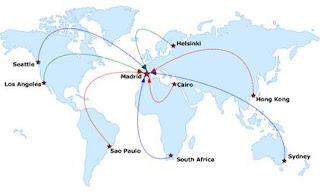
Design
Central site hosts
|
Regional sites host
|
Server farm running Office SharePoint Server, including:
|
Either:
Server farm running Office SharePoint Server, including:
Server farm running Windows SharePoint Services 3.0 including:
|
Guidance
- The distributed solution is recommended for organizations that have many offices distributed geographically, such as branch offices. This solution provides local access to collaboration sites at the regional office. It also provides the ability to share content between a regional site and the central site. For example, the central site can publish content to regional sites for local access. Regional sites can upload content to the central site to consolidate content or to share regional data.
- Because of the number of regional sites, it might not be practical to provide enterprise-wide search in which the central site crawls content on each of the regional sites. However, in a distributed model in which the regional sites are largely autonomous, you can provide users access to content beyond their regional site in the following two ways:
- Implement a governance strategy in which regional sites upload or publish content relevant to the entire organization to the central site. Enable regional users to connect to the central site to search on this content.
- Publish or upload targeted content from the central site to each of the regional sites. Users can search on this content by using their local search service.
COMPARISON
Item
|
Central solution
|
Central with regional sites solution
|
Distributed solution
|
Overall recommendations
|
Preferred if the available network bandwidth across the WAN provides a satisfactory experience for regional users. Advantages include:
|
Use only if the available network bandwidth does not support the use of portal site services and features over the WAN or if the user experience is unacceptable for most SharePoint site use.
Performance of collaboration within each regional site is greatly improved.
Collaboration across the central and regional sites is possible, but performance depends on the WAN links.
|
Use if the available network bandwidth does not support the use of a central solution and there are many regional sites.
This solution does not provide collaboration for teams working across geographical sites. However, this solution greatly increases the performance of collaboration sites within each regional site.
|
Administration
|
Centralized — all server hardware and server farm services are hosted at the central site.
|
Requires regional management of the server farm and services.
|
Requires regional management of the server farm and services.
|
WAN bandwidth
|
All content must be transferred over the WAN. The user experience is dependent on the available bandwidth.
However, the bandwidth load is generated only by the regional users. The central server farm search services do not crawl data at the regional sites, which reduces bandwidth requirements.
|
Collaboration within regional farms does not affect WAN communication.
Profile synchronization uses WAN connections to synchronize profile information across SSPs in all regional farms.
If the regional site chooses to use enterprise-wide search services, network bandwidth across the WAN is required to send and receive results to search queries and to download content associated with search queries.
Additionally, if the regional site chooses to be included in enterprise-wide search scopes, the central site search service uses a significant amount of bandwidth to crawl the regional content. Search can consume all network resources on the WAN link when in operation over that link.
|
Collaboration within regional farms does not affect WAN communication.
Profile synchronization uses WAN connections to synchronize profile information across SSPs in all regional farms.
Content sharing between regional sites and the central site is subject to WAN connections.
Because of the number of regional sites, it might not be practical to provide enterprise-wide search in which the central site crawls content on each of the regional sites.
However, if the regional site chooses to use enterprise-wide search services, network bandwidth across the WAN is required to send and receive results to search queries and to download content associated with search queries.
|
Capacity planning
|
The greatest consideration when planning for capacity at the central site is the available network bandwidth to the regional site.
|
Capacity of the regional server farm can be calculated by using the standard capacity planning guidelines.
If the central site is providing enterprise-wide search to regional sites, be sure to calculate this additional load for the central farm.
|
Capacity of the regional server farm can be calculated by using the standard capacity planning guidelines.
If the central site is providing enterprise-wide search to regional sites, be sure to calculate this additional load for the central farm.
|
Search
|
Search is hosted entirely at the central site, either by the central farm or by a farm dedicated to hosting shared services.
The central search service provides enterprise-wide search. Search administrators at the central farm can also create custom search scopes that are specific to each region. This provides a way for regional users to search only on content that is hosted at their local site.
|
The regional site can use any (or none) of the following search options:
|
The regional site provides regional search.
Because of the number of regional sites, it might not be practical to provide enterprise-wide search in which the central site crawls content on each of the regional sites.
However, users at the regional site can search content at the central site. The central site can also publish selected content to regional sites so this content is available locally for local search. Federated search is also a good option for providing search access to targeted content.
|
Site directory (optional)
|
Some site templates include a site directory. You can use a site directory to list sites that are relevant for specific regional offices.
|
Team sites on regional farms can be connected to your central farm by manually listing these sites in a site directory.
Targeted sites on the central farm can be listed in the site directory of a regional site.
|
Team sites on regional farms can be connected to your central farm by manually listing these sites in a site directory.
Targeted sites on the central farm can be listed in the site directory of a regional site.
|
Crawling content sources
|
A single SSP is recommended for providing enterprise-wide search. Implementing more than one SSP does not allow relevancy to be applied across all of the content.
|
To provide enterprise-wide search, add a content source for each region. Increase the change log retention time on Web applications on regional farms to coordinate with the incremental crawl schedule.
|
To provide enterprise-wide search, add a content source for each region. Increase the change log retention time on Web applications on regional farms to coordinate with the incremental crawl schedule.
|
My Sites
|
A single SSP can host My Sites for the organization.
|
Host My Sites at the region closest to users. Use the Trusted My Site Host Locations feature to ensure that users create only one My Site in the SSP intended for their use.
|
Host My Sites at the region closest to users. Use the Trusted My Site Host Locations feature to ensure that users create only one My Site in the SSP intended for their use.
|
User profiles
|
User profiles are managed at the central site only.
|
To replicate profile information between the central and regional farms, implement the profile replication tool.
|
To replicate profile information between the central and regional farms, implement the profile replication tool.
|
Globalization
|
Sites or site collections can be created in different languages by using language packs. Additionally, site variations allow site owners to publish content translated in different languages in the same site collection. However, the Central Administration site and Shared Services Administration sites are provided in a single language.
|
Same as central solution.
|
Same as central solution.
|
Backup and recovery
|
All backup and recovery procedures are completed at the central site.
|
Performing backup and recovery procedures across the WAN is not recommended. Backup and recovery tasks must be completed at regional sites.
|
Performing backup and recovery procedures across the WAN is not recommended. Backup and recovery tasks must be completed at regional sites.
|
SHAREPOINT FARM ARCHITECTURES
- Single farm, single service application group
- Single farm, multiple service application groups
- Enterprise services farms
- Cross-organization farms
Service Applications
Service applications that are typically deployed for dedicated use by a specific team or department include:
- Excel Services To optimize performance for a targeted team or to isolate sensitive data
- Managed Metadata To allow a team or department to manage their own taxonomy, hierarchies, keywords, and so on. SharePoint Server 2010 combines the results of multiple Managed Metadata service applications, so taxonomies, content types, and other elements can be shared across an organization
- Business Data Connectivity Individual teams or departments can integrate with their own line-of-business data systems and keep the data isolated from the rest of the organization.
SINGLE FARM, SINGLE SERVICE APPLICATION GROUP
Architecture
- In an architecture that includes a single farm and a single service application group, the default service application group is used for all Web applications in the farm. All sites have access to all of the service applications that are deployed in the farm.
Design Diagram
Advantages
- It is the simplest architecture to deploy
- All service applications are available to all Web applications
- Farm resources are used most efficiently
- All service applications are managed centrally
Disadvantages
- Service application data cannot be isolated
- Individual departments or teams cannot manage service applications on their own
Recommendations
- The architecture that includes a single farm and a single service application–group is the recommended configuration for most organizations, at least initially. This configuration works well when you want to host many sites for a single company on the same farm. Use this configuration to meet the following goals:
- We want to optimize the resources required to run service applications within a farm
- We are sharing content and profile data across sites that otherwise require process isolation for performance or security reasons.
SINGLE FARM, SINGLE SERVICE APPLICATION GROUP
Architecture
- If teams require dedicated service applications, build an architecture by using one or more custom groups of service applications. Follow these guidelines:
- Deploy specific service applications for dedicated use by one or more teams within an organization
- Ensure that the dedicated service applications are not also included in the default group
- Create one or more Web applications that use a custom group of service applications. The SharePoint administrator selects the service applications that are included in the custom group.
Design Diagrams
Advantages
- They accommodate multiple organizational goals in the same farm
- Service data can be isolated
- Individual teams or departments can manage the service applications that have been dedicated for their use
- Sites can be configured to use a subset of service applications.
Disadvantages
- They are more complex to configure and manage
- Farm resources are consumed to support multiple instances of some service applications, which can affect performance
Recommendations
- Architectures that include multiple service application groups work well for companies that have divisions or teams that require dedicated service applications or isolated service data, or for sites that are set up with a narrower scope, such as partner collaboration
- Additionally, when multiple groups of service applications are configured, teams and sites can consume services that are offered enterprise-wide, such as profile and search services, while at the same time isolating the use of targeted services for security or performance reasons
ENTERPRISE SERVICES FARMS
Architecture
- An enterprise services farm is a server farm that is dedicated to hosting service applications for an organization. The following diagram shows an enterprise services farm that hosts the most frequently deployed cross-farm service applications. It also shows several common kinds of farms that consume services from an enterprise services farm
Design Diagram
PUBLISHED CONTENT-ONLY FARMS (all service applications are remote)/(FARM 2)
Architecture
- We can deploy a server farm without deploying any service applications locally. In Farm 2, no service applications are hosted locally. All service applications are consumed from a separate farm. This configuration works well for content that is published. It reduces the administrative efforts required to host a published content farm and allows an organization to take advantage of centrally managed service applications.
- Use this configuration when we have the following goals:
- We want to optimize the resources within a farm for hosting content, instead of running service applications
- We are integrating with organization-wide profiles, metadata, search, and other centrally managed resources
COLLABORATION FARMS (mix of local and remote service applications)/(Farm3)
Architecture
- We can deploy a server farm without deploying any service applications locally. In Farm 2, no service applications are hosted locally. All service applications are consumed from a separate farm. This configuration works well for content that is published. It reduces the administrative efforts required to host a published content farm and allows an organization to take advantage of centrally managed service applications.
Deciding Factor
- Use this configuration when we have the following goals:
- We want to optimize the resources within a farm for hosting content, instead of running service applications
- We are integrating with organization-wide profiles, metadata, search, and other centrally managed resources
FARM FOR SPECIALIZED DEPARTMENTS (mix of local and remote service applications)/(Farm4)
Architecture
- Some teams within an organization might require a separate deployment of specific services for the following reasons:
- To ensure data isolation (such as Business Data Connectivity data)
- To provide the ability to autonomously manage service applications (such as Managed Metadata)
Characteristics
- The characteristics of this farm include the following:
- It consumes centrally managed service applications that include Managed Metadata
- It also includes its own Managed Metadata service application, so this team can autonomously manage its own metadata. Because this service application is shared, the metadata from the rest of the organization can be integrated with this metadata
Deciding Factor
- Use this configuration to meet the following goals:
- Allow a specialized team or department to manage metadata on their own
- Ensure that specific service data is isolated and managed separately from the rest of the organization
CROSS ORGANIZATIONAL FARMS
Architecture
- Service applications can be shared across any farm, not only enterprise services farms. Consider sharing service applications across farms in the following scenarios
Scenario A
- To provide enterprise-wide service applications without a dedicated enterprise services farm, as shown in the following diagram
Scenario B
- To share resources across farms and to avoid deploying redundant service applications, as shown in the following diagram.
-->
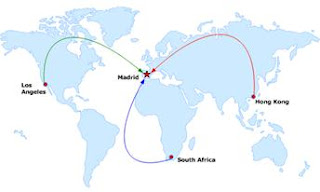
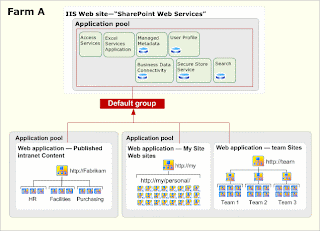






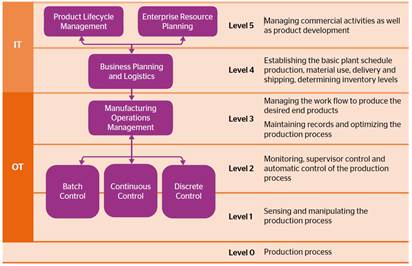
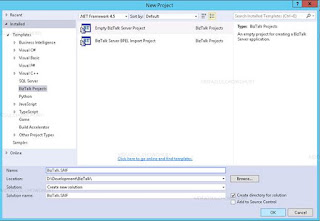
Comments
Post a Comment